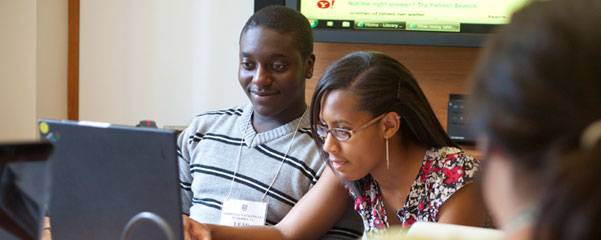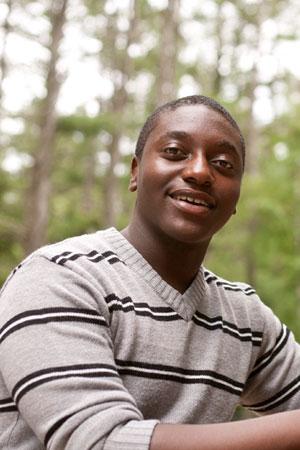LEADers of the Pack
Talented high school students gain exposure to the principles of business.

On a sunny afternoon in July, 30 high school students from around the country are stationed in the classroom level of Byrne Hall, listening to Professor Robert Shumsky explain the rudiments of operations management. “Operations is the study of how businesses get things done,” he tells them, and then launches into a game to illustrate how product pricing can be manipulated to manage capacity and maximize revenue. Despite the blue sky beckoning outside, the students sit in rapt attention for the next 90 minutes.
These rising high school seniors are part of the LEAD (Leadership Education and Development) program, a 30-year-old effort to increase the diversity of business leaders in the United States. It does this by recruiting talented students and then matching them up with one of nine top business schools for a rigorous three-week immersion in business management.
Tuck has hosted LEAD students for the past 15 years, designing a program that includes more than 100 hours of classroom time, most of which is taught pro-bono by full-time Tuck faculty. In addition to operations, the 17- and 18-year-olds take accounting, finance, marketing, leadership, and organizational behavior. Mixed in are a series of experiential activities: a field trip to the Federal Reserve Bank of Boston, a session on the Dartmouth ropes course, and a trip to Manchester, N.H., to watch a minor league baseball game. “After they’ve been in these tough classes seven hours a day for a week,” says Dia Draper, associate director of strategic initiatives for Tuck’s Office of Admissions and director of operations for the LEAD program at Tuck, “they think this is great.”
For Goodwill Batalingaya, a LEAD student from Dumfries, Va., it was his first time seeing a baseball game. Born in Rwanda just after the 1994 genocide, he and his family fled to Belgium and then lived in Senegal before arriving in the United States about five years ago. Batalingaya, a varsity soccer and basketball player at Potomac Senior High School, learned about the program from his cousin, a LEAD alumnus in his second year at Morehouse University. “He told me that LEAD helped him a lot to develop business skills,” Batalingaya says. “I was interested automatically, so I applied.”
We spoke with Batalingaya on the eve of his final project presentation: pitching a detailed business plan to a mock board of investors.

What’s your impression of the program?
Honestly, these are tough classes. They’re trying to teach a whole subject to us in a few hours, so it’s rigorous. The professors don’t give you a lot of busy work, but there’s a lot to take in and they go through material quickly. Sometime you don’t have time to take notes, but you have other classmates who help you. And the professors welcome follow-up questions.
One of your projects was to pick a Google product, design a marketing campaign targeted at a younger audience, and then present it at the Google headquarters in Boston. Tell us about it.
Google works with LEAD and wanted to find a way to attract younger people to Google products. So they asked us to market some of their products. We chose Picnik [a photo editing website] and our market was people around our own age—14 to 23. Google asked us to use our marketing campaign to differentiate Picnik from Photoshop and other software. As marketers, we proposed a limited-time free offer to help our age group get interested in it.
How did you present your ideas at Google?
Each group did it differently, but we all used PowerPoint. We explained our target audience—teenagers—and why. One of our slogans was, “These are the best times of our lives, so pictures are important. Picnik is the best way to save those memories.” In the end, we had a slideshow of pictures from our week of market research on the Dartmouth campus. The judges were really impressed.
What did you take away from that experience?
You have to have character. The way you present yourself is important. Dress nicely, have good posture, speak clearly, things like that. If we started rambling we reminded ourselves to pause and take a breath. From a marketing perspective, we learned that you have to target your campaign precisely, but that’s difficult when you have a range of ages you want to reach.
Tell us about the business plan you’re going pitch.
We came up with an idea for a restaurant that serves international food—American, Hispanic, Asian, Indian, and Italian. For each, we have appetizer-sized meals, and the restaurant is designed to be a casual, comfortable place to hang out with your friends. As one of our professors said, when you’re making a business plan, you’re selling an experience. So we wanted to create a place people can enjoy with their friends and have a light meal.
How did you decide on a restaurant as your business?
We went through lots of ideas—T-shirts, pet funeral services, soccer balls that generate energy and charge appliances—but the restaurant stuck because all of us like food and we thought it would be possible to determine how much it would cost to run the business. Plus, it seemed like a fun business.
What kind of preparation are you doing for your presentation?
A lot of financials. In the Google project, all we had to do was market the product. This time, we had to come up with actual numbers and create a financial plan that included startup costs, loans, and profit margins.
What’s next for you?
I’m looking at colleges now—University of Virginia, Georgetown, Washington University, Dartmouth. For the long term, I have a wide range of interests, including medicine and engineering, so we’ll see.
Over 65 percent of LEAD alumni eventually pursue careers in business and some get MBAs. Some of them even end up at Tuck!